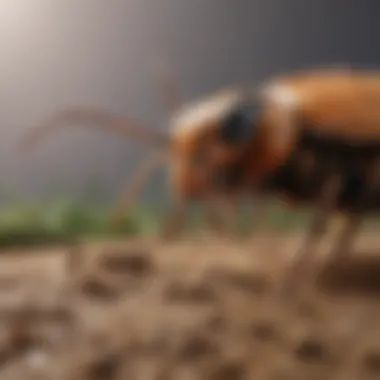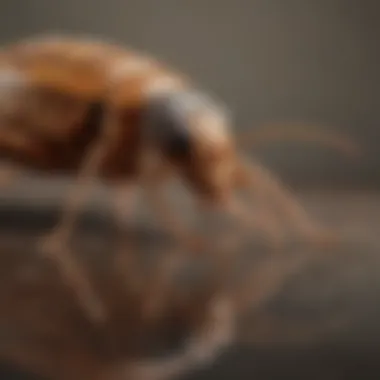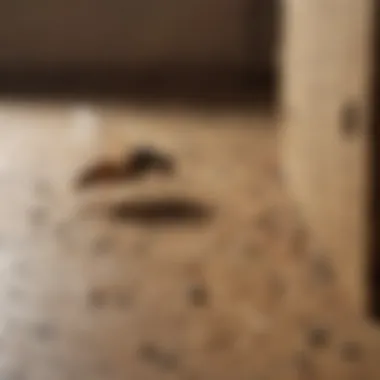Effective Strategies for Termite and Pest Control


Intro
Pests, especially termites, can pose significant challenges for homeowners. Understanding these pests is crucial for effective management and control. This article will delve into various strategies to combat termites and other pests, offering a comprehensive guide for those looking to protect their homes. We will explore essential concepts like pest identification, preventive measures, and control methods, providing valuable insights tailored for homeowners.
Understanding the Pest
Identification
Correct identification of pests is the first step towards effective control. Termites can be particularly destructive, with some species causing substantial damage to wooden structures. Each type of termite, such as the Eastern subterranean termite or the Formosan termite, exhibits distinct characteristics. Signs of termite infestation include hollow-sounding wood, discarded wings, and mud tubes.
Life Cycle
Understanding the life cycle of termites helps in developing targeted strategies for control. Termites undergo complete metamorphosis, where they transition through several stages: egg, nymph, adult, and reproductive.
- Eggs: Laid in clusters, these eggs hatch into nymphs.
- Nymphs: They resemble adults but lack wings.
- Adults: They become workers, soldiers, or reproductive members.
Each stage requires specific conditions for survival, which can be exploited for control.
Pest Prevention Strategies
Environment Modification
Modifying the environment around the home is an effective preventive measure against pests. Keep wood piles and organic debris away from the foundation to reduce attraction.
- Ensure proper drainage to avoid moisture accumulation.
- Seal cracks and crevices in building materials to eliminate entry points.
- Use mulch sparingly near the structure.
Physical Barriers
Installing physical barriers can provide immense protection.
- Mesh screens can prevent entry through vents and openings.
- Boric acid treatments can also be applied in susceptible areas to deter infestations.
- Concrete barriers may be beneficial in controlling subterranean termites, as they cannot burrow through concrete.
Control Methods
Chemical Control
Chemical treatment remains a common approach to pest management. Chemical pesticides vary in formulation and application.
- Liquid insecticides are often injected into the ground near the foundation.
- Baits can be placed strategically around the home, targeting foraging workers.
Some commonly used products are Termidor and Advance 375A, which are known for their efficacy.
Biological Control
Biological control methods use natural enemies to combat pest populations. Introducing nematodes or certain fungi can be effective against termites.
Studies show that biological methods, when correctly employed, reduce chemical use significantly, contributing to a safer environment.
Prologue to Pest Control
Pest control is an essential subject for maintaining a safe and healthy living environment. It involves the management of various species of pests, which can range from insects to rodents, impacting homes and properties globally. Effective pest control strategies are necessary for homeowners to protect their investments and ensure a comfortable living space. Without proper control, pests can cause significant damage, not only to structures, but also to health. Understanding the full scope of pest management is critical for achieving long-term results.
Understanding Pests
To effectively manage pests, it is crucial to understand their behavior and biology. Pests are organisms that can cause harm or nuisance in human environments. They reproduce quickly, thrive in various conditions, and often become resistant to treatments over time. Each type of pest has unique habits, habitats, and vulnerabilities.
Such knowledge helps homeowners to adequately identify the specific pests present in their spaces. For example, termites feed on wood and can silently damage the structural integrity of a home for years before being detected. On the other hand, common pests like ants or cockroaches may carry diseases and require different approaches for control. Understanding these aspects can greatly improve the effectiveness of pest control methods used at home.
The Importance of Pest Control
The importance of pest control cannot be overstated. Effective pest management contributes to healthy living conditions and protects property investments. Besides causing physical damage, pests can pose serious health risks. They can transmit diseases, trigger allergies, and contaminate food and water sources.
For homeowners, proactive measures in pest control can mitigate these risks significantly.


"A proactive approach not only minimizes health risks but also avoids the potential costs associated with extensive pest damage."
To maintain a pest-free environment, employing technology and innovative solutions for pest monitoring and elimination can also be beneficial. Overall, a solid understanding of pest biology combined with effective control methods fosters a safer and more secure home.
Identifying Termites and Common Pests
Identifying termites and common pests is crucial when considering pest control strategies. Knowing what kind of pests are present can determine the methods used for eradication. Different pests have distinct behaviors and habitats, which require specific approaches in treatment. Homeowners equipped with this knowledge can make informed decisions. This reduces the risk of property damage and maintains a healthy living environment.
Types of Termites
Termites are generally categorized into three primary types: subterranean, drywood, and dampwood. Each has unique characteristics that influence how they damage structures.
- Subterranean Termites: These are the most common and typically live underground. They build extensive tunnels and can easily infest homes from the soil beneath. Their colonies can grow large, leading to significant damage over time.
- Drywood Termites: Unlike subterranean termites, drywood termites live in the wood they consume. They can infest furniture or beams in the house directly. These termites do not require moisture from the soil, making them particularly dangerous in drier regions.
- Dampwood Termites: Found mainly in damp areas, these termites prefer rotting wood. They usually are not a threat unless there is existing wood decay. Ensuring wood is dry and treated can help avoid infestations from this type.
Understanding these types is essential for homeowners. Recognizing which termites are prevalent in the area can influence the choice of pest control methods.
Signs of Infestation
Detecting a termite infestation early can save homeowners from costly repairs. There are several key signs to look for when inspecting a property:
- Wood Damage: Hollowed out wood that sounds hollow when tapped is a clear sign that termites are present.
- Mud Tubes: Subterranean termites build mud tubes to maintain moisture while they travel. These tubes are often visible along foundation walls.
- Discarded Wings: Termites shed their wings after swarming, leaving them near windows or doors.
- Frass: This term refers to the wood powder created from termite digestion. Finding small piles of this material around wood structures can indicate an issue.
Monitoring for these signs regularly is vital. Homeowners should conduct inspections, particularly in spring when termite swarming occurs. If signs of an infestation are found, immediate action is recommended.
"Identifying pests early can significantly reduce damage and increase the chances of effective control."
Being proactive about pest identification ensures that strategies implemented are appropriate and effective. Identifying termites and other pests leads to better pest management outcomes.
Chemical Methods of Pest Control
Chemical methods of pest control are essential in effectively managing and eliminating pest infestations. These techniques use synthetic or natural substances to target specific pests, often leading to rapid results. This section will cover the various insecticides, application techniques, and safety considerations crucial for homeowners.
Insecticides Overview
Insecticides are designed to kill or repel insects. They are categorized based on their chemical structure and mode of action. Common types include organophosphates, pyrethroids, and neonicotinoids.
- Organophosphates work by disrupting the nervous system of pests, providing a swift solution.
- Pyrethroids are derived from chrysanthemum flowers and are favored for their low toxicity to humans and pets.
- Neonicotinoids affect the central nervous system, causing paralysis and eventual death of pests.
These products vary in effectiveness depending on the targeted pest and environment conditions. Understanding their properties is key to interested parties.
Application Techniques
Direct Application
Direct application involves placing the insecticide directly onto affected areas or the pests themselves. This method is simple and efficient for localized problems. The main characteristic of direct application is its immediate impact on visible pests. It is often favored in cases of severe infestations where rapid results are needed.
However, potential drawbacks include the risk of overuse, leading to resistance among pests. Proper training and guidelines are important.
Spraying
Spraying is a common application technique, effective for reaching larger areas. It allows for dispersal of the solution over a wide surface, targeting a greater number of pests at once. The key characteristic of spraying is its ability to cover hard-to-reach spaces. This method is popular due to its versatility. It can be used for both indoor and outdoor pest control.
However, wind can affect spray effectiveness, and it's crucial to select a day with minimal movement of the air.
Granular Treatments
Granular treatments involve spreading insecticide granules in targeted areas, such as gardens or around the foundation of buildings. The main advantage of granular methods is their ease of use and lower risk of drift. This method is especially effective for controlling soil-dwelling pests. The unique feature of granular treatments is their persistence in the environment, often reducing the need for repeated applications.
However, it is essential to ensure pets or children don't come into contact with treated areas until the granules have settled.
Safety Considerations
When using chemical methods for pest control, safety cannot be stressed enough. Homeowners should adhere to product labels and manufacturer guidelines. Some key points to consider include:


- Personal Protective Equipment (PPE): Always wear suitable gear including gloves, masks, and goggles to protect against exposure.
- Ventilation: Ensure the area is well-ventilated during and after application to minimize inhalation of fumes.
- Storage: Keep chemicals out of reach of children and pets, in a cool, dry place.
"Proper safety measures ensure effective pest control while minimizing harm to people and pets."
It's important to approach chemical pest control with caution. Awareness of proper techniques and precautions can lead to effective pest management.
Eco-Friendly Pest Control Solutions
Eco-friendly pest control solutions are becoming increasingly critical in managing household pests without harming the environment. These methods focus on safeguarding health while effectively controlling pest populations. Utilizing sustainable practices not only helps preserve ecosystems but also reduces chemical exposure in homes, providing peace of mind to homeowners.
By selecting natural methods over traditional chemical treatments, individuals contribute to environmental preservation. Many eco-friendly options are effective, and they often have fewer side effects compared to their chemical counterparts. The growing demand for green solutions reflects a shift in how pest management is conceptualized and practiced.
Natural Insecticides
Natural insecticides are a core component of eco-friendly pest control strategies. They derive from natural sources, minimizing harm to non-target organisms and the environment. This kind of insecticide is often preferred by homeowners seeking effective yet less toxic alternatives.
Essential Oils
Essential oils have gained popularity as natural insecticides. They are derived from plant extracts and are known for their strong scents, which can repel various pests. For example, oils such as peppermint and tea tree have shown effectiveness against ants and spiders.
The key characteristic of essential oils is their ability to act as both repellents and insecticides. This makes them a dual-purpose solution in pest management. One unique feature of essential oils is their biodegradable nature. This ensures that when used correctly, they do not remain in the environment. However, it is important to note that their effectiveness can vary greatly depending on the concentration and application method.
While essential oils are generally safe, they can sometimes cause allergic reactions in sensitive individuals. Therefore, testing for reactions before widespread application is advised. Still, their popularity in eco-friendly pest control continues to grow.
Soap Solutions
Soap solutions also serve as valuable natural insecticides. They work by suffocating soft-bodied insects and disrupting their cell membranes. This mechanism makes them particularly effective against aphids and spider mites.
The key characteristic of soap solutions is their simplicity. They can be easily made at home by mixing liquid soap and water. This accessibility makes them an attractive option for many homeowners. The unique feature here is their ability to control pests without leaving harmful residues. Unlike some chemical pesticides, soap solutions break down quickly in the environment.
Though generally safe, they can be harmful to beneficial insects if applied directly. Thus, timing and application are critical to minimize non-target organism impact. Soap solutions represent a sustainable choice in pest management, aligning with the goal of minimizing environmental harm.
Beneficial Insects in Pest Management
Having beneficial insects in the garden is a natural way to control pest populations. These insects, such as ladybugs and lacewings, feed on pests like aphids and caterpillars. By encouraging the presence of these natural predators, homeowners can establish a more balanced ecosystem.
Creating a habitat for beneficial insects involves planting diverse flora and providing sources of water. This promotes their lifecycle and helps keep pest populations in check. Preserving natural habitats around the home also supports these beneficial species.
In summary, eco-friendly pest control solutions present effective ways to manage pests while considering human health and environmental impacts. These methods are integral to sustainable pest management practices, blending effectiveness with responsibility.
Preventive Measures for Pest Control
Pest control is not merely about reactive measures. To effectively manage termites and other pests, preventive measures play a crucial role. These strategies help mitigate the risk of infestations before they begin. They are cost-effective and can save homeowners from the stress and expense associated with pest problems.
Regular Inspections
Conducting regular inspections is essential in maintaining a pest-free environment. Homeowners should make it a habit to examine their property for any signs of pests or conditions conducive to infestations. Inspections help in early detection, allowing for timely interventions before larger issues arise.
- Focus on areas such as basements, attics, and crawl spaces, where pests are likely to nest.
- Look for signs of damage, droppings, or even nests that can indicate the presence of pests.
- Perform these inspections at least twice a year to catch potential problems early.
"A small problem today can become a huge pest issue tomorrow."
Home Maintenance Practices
Sealing Entry Points
Sealing entry points is an effective strategy to prevent pests from gaining access to your home. This includes windows, doors, and any cracks in walls or foundations.
- One key characteristic of sealing is that it creates a barrier against pests.
- This method is beneficial because it not only protects against termites but also a variety of other insects.
- Unique features include using caulking and weather stripping to close gaps. The main advantage lies in its simplicity and low cost. However, homeowners must regularly check seals for wear and tear.
Managing Moisture Levels
Pests like termites thrive in moist environments, making moisture management vital. Maintaining proper moisture levels helps in keeping pests at bay.


- One of the key aspects of managing moisture levels involves ensuring good drainage around the property.
- This choice is popular because it naturally limits pest attraction without the need for chemicals.
- Unique features include using dehumidifiers in basements and fixing leaks promptly. The primary advantage is the reduction of conditions that attract pests. However, it may require ongoing attention to maintain proper levels.
Innovative Pest Control Technologies
Innovations in pest control are fundamentally transforming how homeowners manage infestations. These technologies enhance efficiency and effectiveness, offering a modern approach compared to traditional methods. The integration of technology can not only improve outcomes but also reduce the use of harmful chemicals, aligning with eco-friendly practices. Understanding these innovative tools is essential for homeowners looking to maintain a pest-free environment.
Smart Traps
Smart traps represent a notable advancement in pest control. They use sensors and smart technology to detect pests and monitor activity levels. These traps can provide immediate alerts to homeowners or pest control services about infestations. The benefits of smart traps include:
- Real-time Monitoring: Homeowners can receive notifications, which allows for quick responses to pest activities.
- Environmental Considerations: Many smart traps are designed to minimize chemical use, focusing instead on traps that capture pests without toxin exposure.
- Data Analytics: Some traps gather data on pest populations, indicating trends and patterns which can help in proactive pest management.
- User-Friendly Technology: Many smart traps come with apps that allow users to track usage and effectiveness, making it straightforward for any homeowner.
This technology not only makes tracking pests easier but also empowers homeowners with valuable information to make informed decisions regarding pest management strategies.
Remote Monitoring Systems
Remote monitoring systems take pest control to the next level by integrating surveillance with pest management. These systems usually consist of multiple devices strategically placed around a property. Homeowners can access real-time data remotely via connected apps.
The following points highlight the advantages of remote monitoring systems:
- Continuous Surveillance: These systems allow for 24/7 monitoring of premises, which is particularly crucial in detecting infestations early.
- Cost-Effective Solutions: By identifying problems early, remote monitoring can potentially save homeowners significant amounts in repair and treatment costs.
- Integration with Other Technologies: Many systems can integrate seamlessly with home security systems, adding another layer of protection for homeowners.
- Quick Response Capabilities: If an infestation is detected, immediate alerts are sent to homeowners, enabling prompt action.
"Being informed about pest activity in real time can significantly improve pest management strategies and outcomes."
Understanding these systems' capabilities is vital for homeowners who want to employ modern strategies in pest control. Investing in these technologies not only addresses current pest problems but also helps in preventing future infestations effectively.
The Role of Professionals in Pest Control
Effective pest control is an intricate endeavor that requires expertise, knowledge, and appropriate tools. When faced with a pest issue, homeowners may wonder whether to handle it themselves or hire a professional. Understanding the role of professionals in pest control provides clarity on the benefits and necessity of their services.
Professionals are trained to identify various types of pests and their behaviors, which is crucial for effective management. This specialized knowledge allows them to determine the most suitable control method, ensuring that the solution is both effective and safe for occupants and pets. Additionally, pest control experts often have access to advanced technologies and products not available to the general public. Their experience with pest elimination techniques is vital in developing a tailored approach for each specific infestation.
It is important to recognize that certain pests can cause significant damage to property, including termites which may compromise structural integrity. Thus, timely intervention from professionals can prevent further destruction and costly repairs. By relying on trained specialists, homeowners can also prioritize long-term results rather than temporary fixes.
"In most cases, the prevention of pest issues is easier and less expensive than dealing with infestations."
When to Hire a Pest Control Expert
Knowing when to consult an expert can save time and resources. Here are key situations when hiring a pest control expert is advisable:
- Signs of Infestation: If you notice signs of pests, such as droppings, nests, or visible damage, it is crucial to act quickly.
- Difficulty in Handling: Some infestations, like those involving termites or bed bugs, require specific methods that may be challenging for a homeowner to undertake effectively.
- Recurrent Pest Problems: If certain pests seem to return despite your own efforts, it may indicate a deeper, ongoing issue that needs professional intervention.
- Health Concerns: Pests like rodents and cockroaches can pose health risks. Their presence warrants an immediate professional assessment to mitigate potential hazards.
What to Expect from a Pest Control Service
Hiring a pest control service involves an understanding of what the process entails:
- Initial Inspection: A qualified technician will generally perform a thorough inspection of the property to identify pest types, and the extent of the infestation, and any potential breeding grounds.
- Tailored Action Plan: The pest control expert will create a custom plan suited to the specific situation, which may include a combination of chemical treatments, eco-friendly solutions, or physical removal methods.
- Application of Treatments: During this phase, the expert will apply the necessary treatments as outlined in the plan, ensuring all safety measures are followed.
- Ongoing Monitoring: Following treatment, the professional may schedule follow-up visits to monitor the situation. Ongoing assessments are essential for ensuring the problem has been thoroughly addressed.
- Education for Homeowners: Many pest control experts will provide advice on how to prevent future infestations. This may include home maintenance tips and recommendations for keeping the home pest-free.
Finale and Best Practices
The section on Conclusion and Best Practices serves as a crucial summary of the varied strategies discussed throughout this article. It emphasizes the need for homeowners to comprehend the diverse methods available for termite and pest control, guiding them toward informed decisions for their specific situations.
Recognizing that each pest problem is unique is fundamental. Various techniques have unique merits that can be aligned with individual circumstances. Adopting an integrative approach is advantageous. This includes using chemical treatments where necessary, while also considering eco-friendly alternatives that reduce environmental impact. It is vital to balance effectiveness with safety to ensure a healthy living space for families and pets.
This final section distills the salient points from previous discussions, instilling confidence in readers as they consider best practices applicable to their homes.
Summary of Key Points
- A comprehensive understanding of pest biology is essential for effective control.
- Both chemical and eco-friendly pest management strategies are available.
- Regular home maintenance can prevent infestations.
- Innovative technologies such as smart traps are emerging in pest control.
- Hiring professionals may be essential for severe infestations.
"Pest management requires a blend of knowledge, strategy, and maintenance for effective outcomes."
These key points reinforce the importance of a multi-faceted approach when addressing termite and pest issues. Homeowners are encouraged to assess their situations guided by these takeaways.
Final Tips for Homeowners
To wrap up, here are some targeted recommendations for homeowners:
- Conduct Regular Inspections: Be vigilant about checking your property for any signs of pest activity. Early detection can save considerable time and expense.
- Emphasize Home Maintenance: Seal cracks and crevices to prevent pests from entering. Managing moisture levels indoors also reduces attraction for pests like termites.
- Choose the Right Products: When selecting pest control products, ensure they are appropriate for your specific pest problem. Consult instructions and consider safety for household members and pets.
- Consider Professional Help When Needed: If infestations persist or are widespread, don’t hesitate to contact qualified pest control services for expert advice and treatment.
By applying these final tips, homeowners can create a proactive approach to pest management, effectively maintaining a pest-free environment.







